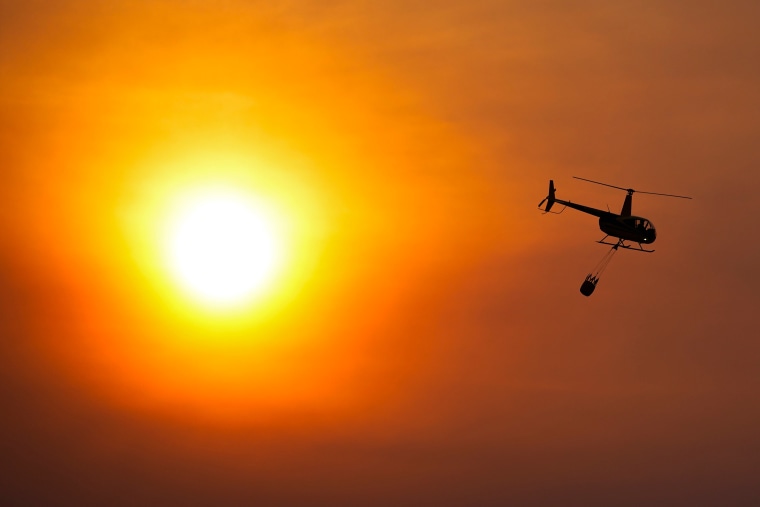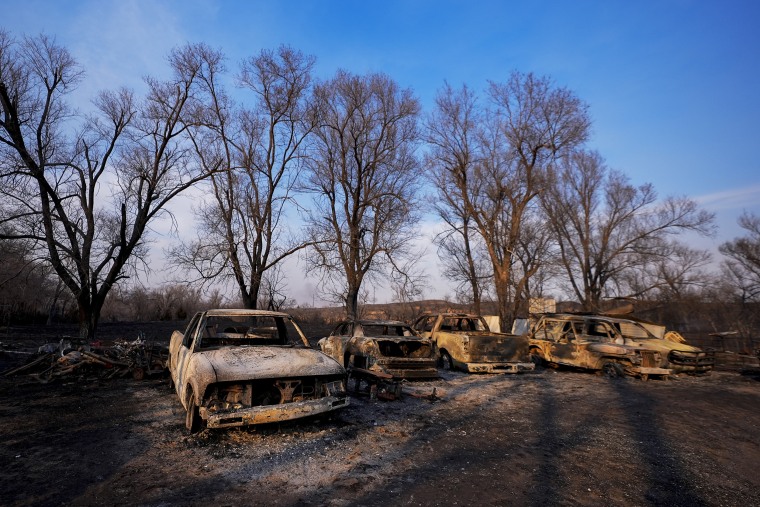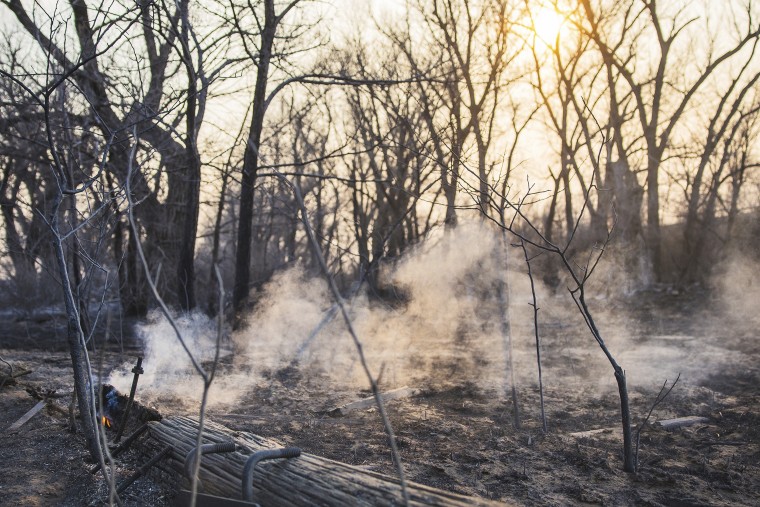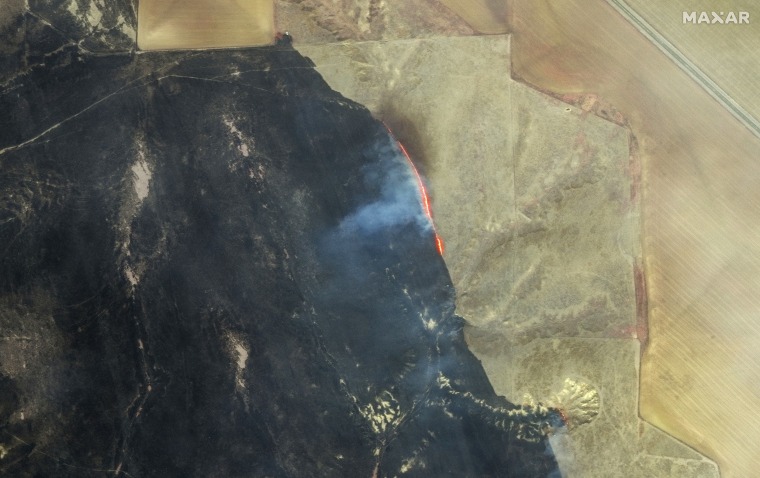Fire crews battling to contain fires ahead of stronger, warmer winds at the weekend
Fire crews are working hard today to combat the enormous wildfire at Smokehouse Creek, before heightened winds tomorrow and into the weekend threatened to make their jobs much harder, the local forest service has said.
“Fire crews are really taking that into consideration, we really want to take advantage of the weather that we have,” Juan Rodriguez, public information officer of Texas A&M Forest Service, told NBC News this morning.
He continued: “So, as of today, crews are going to be working on the southern part of the fires. We’re trying to get a lot of those fire edges really buttoned up today.”
The forest service’s forecast puts the risk for the Panhandle at “very high” tomorrow, from its current “high” rating.
The Smokehouse Fire, which has reached 850,000 acres and is the second-biggest in Texas history but is only 3% contained, took emergency services by surprise. Rodriguez said the panhandle region is no stranger to fast-moving wildfires, but not with this scale or speed.
“It was caused by high winds on Monday and Tuesday this week. It made those two days extremely receptive to burn,” he said.
“It really took everyone by surprise, just the amount of distance that this fire had on it, spreading over 50 miles in a matter of 24 hours was pretty incredible to see.”
In Texas, a powerful combination of dry land and high winds fuels wildfires

Abnormally warm temperatures, dry grasses and a sudden windy cold front combined to create the conditions for the destructive wildfires that have raged across parts of Texas this week.
The winds that sent wildfires charging across the Texas Panhandle struck at the perfect time of day for destruction, “like a hurricane making landfall at high tide,” Texas State Climatologist John Nielson-Gammon said. Hot, dry temperatures — the kind that can be spurred by climate change — helped create conditions for those fires to take off, he added.
On Monday, temperatures in some parts of the dry northern region of the state reached the mid-80s, and several wildfires began to burn.
The next day, Arctic air plunged down from the north in a bitter cold front. Winds on both sides of that front — which exceeded 50 mph at times — sent flames roaring through dormant grasses, Nielsen-Gammon said. The cold front arrived in the late afternoon, when wind speeds were highest, and also changed directions as it passed through, maximizing how quickly the fire spread.
Smokehouse Creek Fire leaves charred vehicles in its wake
Charred vehicles sit at an auto body shop after the property was burned by the Smokehouse Creek Fire in Canadian, Texas, yesterday.

As wildfires burn, snow is on the way to the Texas Panhandle
These rare winter wildfires come as Texas prepares for an unlikely weather event: historic wildfires met with rain and snow.
The National Weather Service in Amarillo said early today that snow or rain, or a mixture of the two, was due to hit the southwestern Texas Panhandle between 7 a.m. and 12 p.m. local time.
A prediction map from NWS show that snow could fall on the Windy Deuce fire north of Amarillo, which covers more than 140,000 acres and is only 30% contained.
Only half an inch of snow is expected, although the NWS said this could rise to a full inch.
Charred homes, blackened earth after Texas town revisited by destructive wildfire 10 years later
FRITCH, Texas. — The small town of Fritch is again picking through the rubble of a Texas wildfire, a decade after another destructive blaze burned hundreds of homes and left deep scars in the Panhandle community.
Residents in and around Fritch and other rural towns fled for safety Tuesday afternoon as high winds whipped the flames into residential areas and through cattle ranches.
Fritch Mayor Tom Ray said on Wednesday the town’s northern edge was hit by a devastating wildfire in 2014, while this week’s blaze burned mostly to the south of the town, sparing the residents who live in the heart of the community.
“I said, ‘Oh Lord, please don’t come down the middle,’” Ray said.
The mayor estimated up to 50 homes were destroyed near Fritch, with dozens more reportedly consumed by fire in small towns throughout the Panhandle.
The cluster of blazes included a fire that grew into one of the largest in state history. An 83-year-old grandmother from the tiny town of Stinnett was the lone confirmed fatality. However, authorities have yet to make a thorough search for victims and have warned the damage to some communities is extensive.
The cause of this week’s fires is still unknown but dry, warmer than average conditions combined with high winds caused blazes that sparked to grow exponentially, prompting evacuations across a more than 100 mile (160 kilometer) stretch of small towns and cattle ranches from Fritch east into Oklahoma.
Photos showed homes throughout the area reduced to unrecognizable piles of ash and bricks with charred vehicles and blackened earth.
Dramatic wildfire drone video shows scorched, smoldering Texas landscape
Drone video, captured about 90 miles northeast of Amarillo, showed a scorched area bordered by two of the Texas wildfires.
Emergency teams activated as wildfires spread into Oklahoma
First responders have been deployed in Oklahoma as wildfires spread throughout the state, having moved east from the Texas Panhandle.
As of last night, at least 12 fires were burning, covering more than 115,000 acres in Oklahoma, including a fire at Slapout in Beaver County, which covered an estimated 76,800 acres and was zero percent contained.
“On the heels of an impactful wildfire, we are preparing for another round of significant fire weather over dry, heavily loaded fuelscapes,” the Oklahoma Forestry Commission said in an update.
Gov. Kevin Stitt said yesterday that emergency response teams in the state had been activated.
Smoke rises from a scorched forest
Charred tree trunks pictured after the Smokehouse Creek Fire moved through Canadian, Texas, yesterday.

Eyewitness video shows burned-out buildings in Canadian, Texas
Video posted on social media showed burning and blackened buildings in the Texas town of Canadian, at the forefront of the deadly wildfires.
Cruz tells affected Texans to be ‘ready to move out of harm’s way’
Sen. Ted Cruz, R-Texas, has said people affected by the wildfires raging through the Texas Panhandle need to be ready to move if necessary.
Posting on X late yesterday, he said: “The fires in the Texas Panhandle are raging ferociously. My team in the state is continuously monitoring the ongoing situation closely.”
He added: “We need those who are impacted to listen to your local officials’ warnings and be prepared to move out of harms way.”
How to help victims of the Texas wildfires
Well-wishers from Texas and beyond are being urged to donate money and practical items to help people affected by the Texas wildfires, particularly farmers and ranchers in the panhandle.
The Texas A&M AgriLife Extension said in a Facebook post last night that anyone could donate money to funds run by the Amarillo National Bank and the Hutchinson County United Way Relief Fund.
The Red Cross, which is running a shelter at the Dome Civic and Convention Center in Borger, is asking for essentials such as water, diapers, wet wipes and nonperishable food — but not clothing or furniture.
The Volunteer Fire Department in Stinnett has asked for the same, while a livestock supply point was due to be set up in Pampa with a request for wire, cedar posts, hay, feed and portable diesel.
“Thank you for your love and concern for the residents of Hutchinson County and all the Texas Panhandle towns as we begin to wrap our heads around this disaster,” the A&M AgriLife Extension said.
Satellite infrared image reveals areas scorched by wildfire
This satellite color infrared image provided by Maxar Technologies shows an active fire line and burn scars from the Smokehouse Creek wildfire northwest of Miami, Texas, yesterday.
Burned vegetation appears in shades of black/gray and healthy, not burned, vegetation appears in shades of red/pink. A cluster of wildfires is scorching the Texas Panhandle, including a blaze that grew into one of the largest in state history.

More than 1 million acres are burning across Texas
An area covering more than 1,500 square miles, more than 1 million acres, was burning across the state of Texas as of 3.30 a.m. ET, according to the Texas A&M Forest Service.
At least 23 fires were burning — the biggest of them, at Smokehouse Creek, covers more than 850,000 acres and is only 3% contained.
Several smaller fires, many of them in the western part of the state with some covering just 1 acre, have been put out.
‘It was getting hard to breathe’: Texas couple recalls massive wildfire
A Texas couple talks to NBC News’ Tom Llamas about the impact of the wildfire burning across the panhandle. Video provided by the couple shows flames from the fire near the motel they own.
More hot, windy weather in store for weekend
The National Weather Service in Amarillo says the region faces a forecast that will likely cause “critical fire weather conditions again.”
Highs will get into the high-70s starting tomorrow, but on Saturday and Sunday high winds of 20 mph to 35 mph are forecast. Heat and high winds help fuel wildfires like those seen in the Texas Panhandle, which are ongoing.
Today, there is a chance of a wintry mix for some of the areas in the panhandle impacted by the fires, the weather service said.
First appeared on www.nbcnews.com




